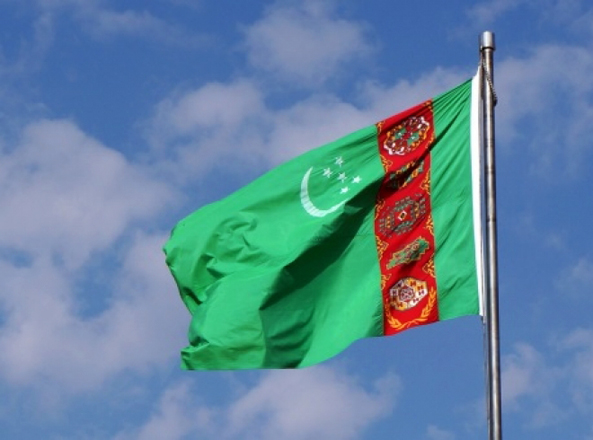Turkmenistan remains key natural gas holder in Central Asia

By Kamila Aliyeva
Turkmenistan remains a key natural gas holder in the center of Eurasia, an area which has long failed to realize its huge potential due to geopolitical developments and economic changes.
The total natural gas reserves of Turkmenistan are estimated at 50.4 trillion cubic meters, Trend reported citing a source in the country’s fuel and energy complex.
As many as 19 oil and gas-oil and 65 gas fields were identified in Turkmenistan so far.
After the UK’s Gaffney, Cline & Associates carried out an independent appraisal of reserves and resources of natural gas at the Galkynysh field, Turkmenistan ranked 4th in the world in terms of proven natural gas reserves. As for the world’s second biggest gas field, Galkynysh, located in the eastern part of Turkmenistan, it is stated that this filed is unique for its geological conditions.
The recently revised data shows that the reserves of Galkynysh and the nearby fields are estimated at 27.4 trillion cubic meters. Of them, 21.2 trillion cubic meters of gas account for Galkynysh, 5 trillion cubic meters account for Yashlar and 1.2 trillion cubic meters account for the nearby Garakel field.
Today, Turkmenistan is among the main suppliers of natural gas in the Central Asian region and is the largest supplier of natural gas to China. Turkmenistan earns much of its GDP from the natural gas extraction and export.
Turkmenistan does not border directly with huge markets such as Europe, China, or India, and depends on transiting gas through other countries. The Turkmen government's preference is to route transportation through those countries with which it has no or the lowest possible degree of conflict.
Today the three main export routes of the country are Central Asia – Center Pipeline (CAS) to Russia, Central Asia – China pipeline (CACP) and two routes to Iran, which are Korpedzhe-Kurt Kui (KKK) and Dauletabad-Sarakhs-Khangiran pipelines.
Turkmenistan lost Russia as a customer a year ago, and has since provided gas only to China and Iran. The country’s relations with Iran were also seriously damaged by the gas dispute over Iran’s debts. China remains Turkmenistan’s biggest consumer.
The latest major export pipeline system built in Turkmenistan is the Central-Asia China Pipeline system (CACP). It is designed to use four lines (A, B, C and D) starting in Turkmenistan and passing through Uzbekistan and Kazakhstan before reaching China. A, B, and C are parallel pipelines. Line A and B became operational in 2009 and 2010 respectively while line C followed in 2014. Line D will go through a different route passing Uzbekistan, Tajikistan and Kyrgyzstan.
The different path for Line D is probably associated with a Chinese preference to avoid having all its lines run through Kazakhstan and, more importantly, to be able to import gas from Tajikistan, where CNPC is already negotiating exploration and production contracts.
Being the forth in the world for the volume of natural gas reserves, the country is considering the European market as one of the most promising areas of gas supply..
Turkmenistan has long been showing interest in the Trans-Caspian Gas Pipeline Project which involves the construction of a 300-km pipeline along the bottom of the Caspian Sea to the coast of Azerbaijan. It is considered to be the optimal solution for the delivery of Turkmen energy resources to the European markets. Further, along the way, Turkmen gas can be transported through the existing pipelines to Turkey, which borders European countries.
The issue was recently mulled in Baku, where President of Azerbaijan Ilham Aliyev and his Turkmen counterpart Gurbanguly Berdimuhamedov signed a declaration on strategic partnership, which envisages cooperation in the area of energy deliveries to Europe.
Both countries have long been working on organizing natural gas deliveries from the Caspian Sea region, including from Turkmenistan, to Europe while Turkey and the European Union supported this initiative.
Azerbaijan and Turkmenistan stand in favor of the construction of the Trans-Caspian subsea pipeline with the consent of the states whose territories the new pipeline will cross. At the same time, Russia and Iran strongly oppose the project, insisting on the realization of the plan only when the Caspian Sea status would be resolved and the consent of all five littoral states received (Russia, Azerbaijan, Iran, Kazakhstan and Turkmenistan).
Turkmenistan also regards developing the Galkynysh field and building a branch of the Turkmenistan-Afghanistan-Pakistan-India (TAPI) gas pipeline from this field as one of its strategically important areas.
The construction of the Turkmen section of the TAPI was launched in December 2015. The total length of the pipeline is 1,814 kilometers, including 214 kilometers - on the territory of Turkmenistan, 774 kilometers - Afghanistan, 826 kilometers of Pakistan to the settlement of Fazilka on the border with India.
Annual capacity of the gas pipeline will reach 33 billion cubic meters. Total length of TAPI will be 1,814 kilometers. The project's preliminary cost is estimated at $10 billion.
The trans-regional energy project expected to be inaugurated in 2019 is being hailed as a major initiative for bringing peace and enhancing connectivity in the region.
The Central Asian country also plans to build several large gas complexes in the coming years. The country aims at strengthening the development of the gas industry in the next 10 years by implementing numerous projects in this area. Particularly, it is planned to reconstruct a natural gas processing plant and launch production of liquefied gas at the Bagaja deposit in Lebap province.
A big investment project is proposed to be implemented at the field of Central Karakum, located near the Yylanly gas compressor station in the Dashoguz province. As part of the project, it is planned to build a plant to process two billion cubic meters of natural gas and produce 70,000 tons of liquefied gas.
The energy-rich Central Asian nation invites foreign investors to participate in the development of the gas and chemical industry.
---
Kamila Aliyeva is AzerNews’ staff journalist, follow her on Twitter: @Kami_Aliyeva
Follow us on Twitter @AzerNewsAz
